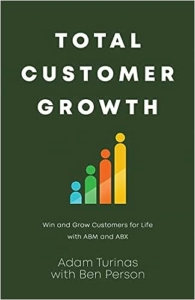Book Review: Total Customer Growth

Account-based Marketing, or ABM, has been around for awhile but there still seems to be some mystery about what it can provide marketing and sales teams, and what components are involved.
Authors Adam Turinas and Ben Person define ABM as having three dimensions: Identifying in-market accounts, focusing on those that fit your Ideal Customer Profile (ICP), and customizing marketing and sales outreach to the buying groups of those accounts.
Total Customer Growth provides a good overview of what ABM is, its advantages, and the process to follow to implement. The book expands into Account-based Experience (ABX), which the authors describe as utilizing ABM techniques through the whole customer lifecycle, not just the initial sale. A plus is that the authors don’t forget about client retention, and show how ABM can be used for that and for cross-selling across a company’s product line.
The authors provide a broad overview of ABM platforms such as Terminus and Demandbase. Their power lies in being able to aggregate first-party (think your website) and third-party intent data, provide a dashboard in Salesforce, and orchestrate display and paid social campaigns, all within the platform.
The book includes a good run-through of an ABM campaign from start to finish in Chapter 17, including how to maximize your marketing efforts by effectively involving sales, including Sales Development Reps (SDRs), and customer support teams.
In the interests of full disclosure, I have worked with Adam on standing up an ABM program for my employer, AMN Healthcare, and so I can attest to his knowledge and expertise. Some impressions as I’ve led our team on this ABM journey this year:
One key is getting the pulse of your current customers in different ways. At AMN, we utilized Adam to conduct interviews with key customers to gain insights into their current and future needs. Our customer service teams are in regular contact with our customers, as one would expect, but we have found that having a third-party speak with them still reveals information we didn’t know. It’s especially valuable if you have a less than satisfied client and you need help identifying what needs to be fixed.
Another layer of customer insight is the customer satisfaction survey. We conduct these surveys yearly among all our service lines to create a more quantitative measure of client satisfaction and their willingness to recommend us (Net Promoter Score, or NPS).
These measures will uncover information about your client relationships that your customer success team didn’t know, and some of it may be unpleasant. However, it’s better to know than not know, so remediation plans can be put into place.
Another key is the use of intent data. Zoominfo and Bombora are the two most-commonly cited sources of this information, outside of sophisticated ABM platforms. I don’t find Zoominfo all that intuitive, but by setting up your target accounts in that platform so you can see third-party web activity is extremely valuable, even better if you integrate Zoominfo into your CRM so sales can see the data on demand without having to learn a new platform.
If you can successfully integrate your marketing automation software such as Pardot with your CRM, Salesforce in AMN’s case, along with your intent data, you can cobble together an effective way to gain insights into your target account list and send out email campaigns or 1:1 emails from your sales or customer service teams via a Salesforce Engage Template.
You need a reliable system so that leads from, let’s say, a white paper download get posted in Salesforce with the right Lead Source Description, are qualified, and assigned to a salesperson. Leads from other sites, such as media outlets, pose a different issue, since they must be uploaded manually. ROI needs to be calculated, and for us that is a spreadsheet that ties together revenue and marketing spend, along with an estimate of what percent of a closed deal was attributable to an ABM campaign. Because of our large deal sizes, we can attribute as little as 5% of a deal’s value to marketing and still come away with an impressive ROI number.
ABM doesn’t replace “old fashioned” lead gen, but in reality there are times when marketing’s efforts result in so many Marketing Qualified Leads (MQLs) that turn into Sales Qualified Leads (SQLs) that they overwhelm the ability of the sales team to follow up. This is where automated drip campaigns come in handy and a key reason to utilize a marketing automation platform in conjunction with your CRM.
Total Customer Growth provides a valuable overview of what ABM is, its advantages, and the process to follow to implement. The authors also have online resources to complement the book’s content.
Note: No Generative AI was harmed (or used) in the writing of this article.


